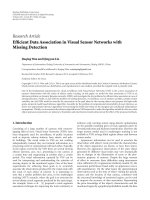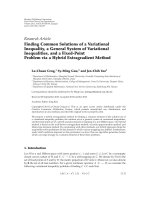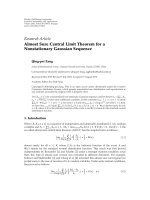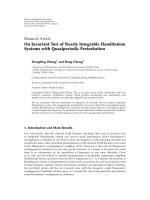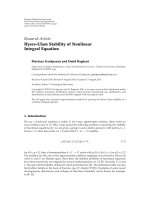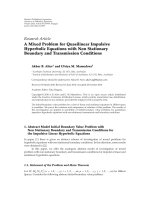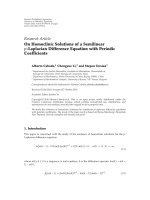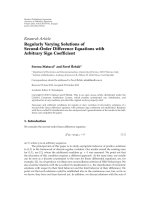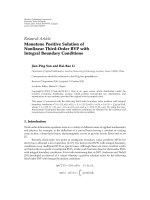Báo cáo hóa học: "Research Article Almost Periodic Solutions of Nonlinear Discrete Volterra Equations with Unbounded Delay" ppt
Bạn đang xem bản rút gọn của tài liệu. Xem và tải ngay bản đầy đủ của tài liệu tại đây (517.98 KB, 15 trang )
Hindawi Publishing Corporation
Advances in Difference Equations
Volume 2008, Article ID 692713, 15 pages
doi:10.1155/2008/692713
Research Article
Almost Periodic Solutions of Nonlinear Discrete
Volterra Equations with Unbounded Delay
Sung Kyu Choi and Namjip Koo
Department of Mathematics, Chungnam National University, Daejeon 305-764, South Korea
Correspondence should be addressed to Namjip Koo,
Received 30 June 2008; Revised 18 September 2008; Accepted 14 October 2008
Recommended by Mariella Cecchi
We study the existence of almost periodic solutions for nonlinear discrete Volterra equations with
unbounded delay, as a discrete analogue of the results for integro-differential equations by Y.
Hamaya 1993.
Copyright q 2008 S. K. Choi and N. Koo. This is an open access article distributed under the
Creative Commons Attribution License, which permits unrestricted use, distribution, and
reproduction in any medium, provided the original work is properly cited.
1. Introduction
Hamaya 1 discussed the relationship between stability under disturbances from hull and
total stability for the integro-differential equation
x
tft, xt
0
−∞
F
t, s, xt s,xt
ds, 1.1
where f : R × R
n
→ R
n
is continuous and is almost periodic in t uniformly for x ∈ R
n
,and
F : R×−∞, 0×R
n
×R
n
→ R
n
is continuous and is almost periodic in t uniformly for s, x, y ∈
−∞, 0×R
n
×R
n
. He showed that for a periodic integro-differential equation, uniform stability
and stability under disturbances from hull are equivalent. Also, he showed the existence of
an almost periodic solution under the assumption of total stability in 2.
Song and Tian 3 studied periodic and almost periodic solutions of discrete Volterra
equations with unbounded delay of the form
xn 1f
n, xn
n
j−∞
B
n, j, xj,xn
,n∈ Z
, 1.2
2 Advances in Difference Equations
where f : Z × R
n
→ R
n
is continuous in x ∈ R
n
for every n ∈ Z, and for any j,n ∈ Z j ≤ n,
B : Z × Z × R
n
× R
n
→ R
n
is continuous for x, y ∈ R
n
. They showed that under some suitable
conditions, if the bounded solution of 1.2 is totally stable, then it is an asymptotically almost
periodic solution of 1.2,and1.2 has an almost periodic solution. Also, Song 4 proved
that if the bounded solution of 1.2 is uniformly asymptotically stable, then 1.2 has an
almost periodic solution.
Equation 1.2 is a discrete analogue of the integro-differential equation 1.1,and1.2
is a summation equation that is a natural analogue of this integro-differential equation. For
the asymptotic properties of discrete Volterra equations, see 5.
In this paper, in order to obtain an existence theorem for an almost periodic solution of
a discrete Volterra equations with unbounded delay, we will employ to change Hamaya’s
results in 1 for the integro-differential equation into results for the discrete Volterra
equation.
2. Preliminaries
We denote by R, R
, R
−
, respectively, the set of real numbers, the set of nonnegative real
numbers, and the set of nonpositive real numbers. Let R
n
denote n-dimensional Euclidean
space.
Definition 2.1 see 6. A continuous function f : R × R
n
→ R
n
is called almost periodic in t ∈ R
uniformly for x ∈ R
n
if for any ε>0 there corresponds a number l lε > 0 such that any
interval of length l contains a τ for which
ft τ, x − ft, x
<ε 2.1
for all t ∈ R and x ∈ R
n
.
Let R
∗
R
−
×R
n
×R
n
and let Ft, s, x, y be a function which is defined and continuous
for t ∈ R and s, x, y ∈ R
∗
.
Definition 2.2 see 9. Ft, s, x, y is said to be almost periodic in t uniformly for s, x, y ∈ R
∗
if for any ε>0 and any compact set K
∗
in R
∗
, there exists an L Lε, K
∗
> 0 such that any
interval of length L contains a τ for which
Ft τ, s, x, y − Ft, s, x, y
≤ ε 2.2
for all t ∈ R and all s, x, y ∈ K
∗
.
We denote by Z, Z
, Z
−
, respectively, the set of integers, the set of nonnegative
integers, and the set of nonpositive integers.
Definition 2.3 see 3. A continuous function f : Z×R
n
→ R
n
is said to be almost periodic in n ∈
Z uniformly for x ∈ R
n
if for every ε>0 and every compact set K ⊂ R
n
, there corresponds an
integer N Nε, K > 0 such that among N consecutive integers there is one, here denoted
p, such that
fn p, x − fn, x
<ε 2.3
for all n ∈ Z, uniformly for x ∈ R
n
.
S. K. Choi and N. Koo 3
Definition 2.4 see 3.LetZ
∗
Z
−
× R
n
× R
n
.AsetΣ ⊂ Z
∗
is said to be compact if there is a
finite integer set Δ ⊂ Z
−
and compact set Θ ⊂ R
n
× R
n
such that ΣΔ× Θ.
Definition 2.5. Let B : Z × Z × R
n
× R
n
→ R
n
be continuous for x, y ∈ R
n
, for any j, n ∈ Z,j≤ n.
Bn, j, x, y is said to be almost periodic in n uniformly for j, x, y ∈ Z
∗
if for any ε>0andany
compact set K
∗
⊂ Z
∗
, there exists a number l lε, K
∗
> 0 such that any discrete interval of
length l contains a τ for which
Bn τ,j,x,y − Bn, j, x, y
≤ ε 2.4
for all n ∈ Z and all j, x, y ∈ K
∗
.
For the basic results of almost periodic functions, see 6–8.
Let l
−
R
n
denote the space of all R
n
-valued bounded functions on Z
−
with
φ
∞
sup
n∈Z
−
φn
< ∞ 2.5
for any φ ∈ l
−
R
n
.
Let x : {n ∈ Z : n ≤ k}→R
n
for any integer k. For any n ≤ k, we define the notation
x
n
: Z
−
→ R
n
by the relation
x
n
jxn j2.6
for j ≤ 0.
Consider the discrete Volterra equation with unbounded delay
xn 1f
n, xn
n
j−∞
B
n, j, xj,xn
,n∈ Z
,
f
n, xn
0
j−∞
B
n, n j, xn j,xn
,
2.7
where f : Z × R
n
→ R
n
is continuous in x ∈ R
n
for every n ∈ Z and is almost periodic in n ∈ Z
uniformly for x ∈ R
n
, B : Z × Z × R
n
× R
n
→ R
n
is continuous in x, y ∈ R
n
for any j ≤ n ∈ Z and
is almost periodic in n uniformly for j, x,y ∈ Z
∗
. We assume that, given φ ∈ l
−
R
n
, there is
a solution x of 2.7 such that xnφn for n ∈ Z
−
, passing through 0,φ. Denote by this
solution xnxn, φ.
Let K be any compact subset of R
n
such that φj ∈ K for all j ≤ 0andxnxn, φ ∈
K for all n ≥ 1.
For any φ, ψ ∈ l
−
R
n
,weset
ρφ, ψ
∞
q0
ρ
q
φ, ψ
2
q
1 ρ
q
φ, ψ
, 2.8
4 Advances in Difference Equations
where ρ
q
φ, ψmax
−q≤m≤0
|φm − ψm|,q≥ 0. Then, ρ defines a metric on the space l
−
R
n
.
Note that the induced topology by ρ is the same as the topology of convergence on any finite
subset of Z
−
3.
In view of almost periodicity, for any sequence n
k
⊂ Z
with n
k
→∞as k →∞, there
exists a subsequence n
k
⊂ n
k
such that
f
n n
k
,x
−→ gn, x2.9
uniformly on Z × S for any compact set S ⊂ R
n
,
B
n n
k
,n l n
k
,x,y
−→ Dn, n l, x,y2.10
uniformly on Z × S
∗
for any compact set S
∗
⊂ Z
∗
, gn, x and Dn, n l, x,y are also almost
periodic in n uniformly for x ∈ R
n
, and almost periodic in n uniformly for j, x, y ∈ Z
∗
,
respectively. We define the hull
Hf, B
g,D : 2.9 and 2.10 hold for some sequence
n
k
⊂ Z
with n
k
→∞as k →∞
.
2.11
Note that f, B ∈ Hf,B and for any g,D ∈ Hf,B, we can assume the almost periodicity
of g and D, respectively 3.
Definition 2.6 see 3.Ifg,D ∈ Hf, B, then the equation
xn 1g
n, xn
n
j−∞
D
n, j, xj,xn
,n∈ Z
2.12
is called the limiting equation of 2.7.
For the compact set K in R
n
, p, P ∈ Hf, B, q, Q ∈ Hf, B, we define πp, q and
πP, Q by
πp, qsup
pn, x − qn, x
: n ∈ Z,x∈ K
,
πP, Q
∞
N1
π
N
P, Q
2
N
1 π
N
P, Q
,
2.13
where
π
N
P, Qsup
Pn, j, x, y − Qn, j, x, y
: n ∈ Z,j∈ −N, 0,x,y∈ K
,
π
p, P, q, Q
max
πp, q,πP, Q
,
2.14
respectively. This definition is a discrete analogue of Hamaya’s definition in 1.
S. K. Choi and N. Koo 5
3. Main results
Definition 3.1 see 3.Afunctionφ : Z → R
n
is called asymptotically almost periodic if it is a
sum of an almost periodic function φ
1
and a function φ
2
defined on Z which tends to zero as
n →∞,thatisφnφ
1
nφ
2
n,n∈ Z.
It is known 8 that the decomposition φ φ
1
φ
2
in Definition 3.1 is unique, and φ
is asymptotically almost periodic if and only if for any integer sequence τ
k
with τ
k
→∞as
k →∞, there exists a subsequence τ
k
⊂ τ
k
for which φn τ
k
converges uniformly for
n ∈ Z as k →∞.
Hamaya 9 proved that if the bounded solution xt of the integro-differential
equation 1.1 is asymptotically almost periodic, then xt is almost periodic under the
following assumption:
H for any ε>0 and any compact set C ⊂ R
n
, there exists S Sε, C > 0 such that
−S
−∞
F
t, s, xt s,xt
ds ≤ ε, t ∈ R, 3.1
whenever xσ is continuous and xσ ∈ C for all σ ≤ t.
Also, Islam 10 showed that asymptotic almost periodicity implies almost periodicity
for the bounded solution of the almost periodic integral equation
xtft
t
−∞
F
t, s, xs
ds. 3.2
Throughout this paper, we impose the following assumptions.
H1 For any ε>0andanyτ>0, there exists an integer M Mε, τ > 0 such that
n−M
j−∞
B
n, j, xj,xn
<ε, n∈ Z, 3.3
whenever |xj| <τfor all j ≤ n.
H2 Equation 2.7 has a bounded solution xnxn, φ,thatis,|xn|≤c for some
c ≥ 0, passing through 0,φ, where φ ∈ l
−
R
n
.
Note that assumption H1 holds for any g,D ∈ Hf, B. Also, we assume that the
compact set K in R
n
satisfies ψj ∈ K for all j ≤ 0andynyn, ψ ∈ K for all n ≥ n
0
,
where yn is any solution of the limiting equation of 2.12 and 2.7 .
Theorem 3.2. Under assumptions H1 and H2, if the bounded solution xn is asymptotically
almost periodic, then 2.7 has an almost periodic solution.
Proof. Since xn is asymptotically almost periodic, i t has the decomposition
xnpnqn, 3.4
6 Advances in Difference Equations
where pn is almost periodic in n and qn → 0asn →∞.Letn
k
be a sequence such that
n
k
→∞as k →∞, pn n
k
→ p
∗
n as k →∞,andp
∗
n is also almost periodic. We will prove
that p
∗
n is a solution of 2.7 for n ≥ 1.
Note that, by almost periodicity,
f
n n
k
,x
−→ f
∗
n, x3.5
uniformly on Z × C, where C is a compact set in R
n
,and
B
n n
k
,n j n
k
,x,y
−→ B
∗
n, n j, x, y3.6
uniformly on Z × K
∗
, where K
∗
is a compact subset of Z
∗
Z
−
× R
n
× R
n
.
Let x
k
nxn n
k
,n n
k
≥ 0. Then, we obtain
x
n n
k
1
f
n n
k
,x
n n
k
nn
k
j−∞
B
n n
k
,j,xj,x
n n
k
f
n n
k
,x
k
n
n
j−∞
B
n n
k
,j n
k
,x
k
j,x
k
n
.
3.7
This implies that x
k
n is a solution of
xn 1f
n n
k
,xn
n
j−∞
B
n n
k
,j n
k
,xj,xn
. 3.8
For n ≤ 0,p
∗
n ∈ K since
p
n n
k
≤
x
n n
k
q
n n
k
≤ c
q
n n
k
,n n
k
≥ 0.
3.9
Moreover, for any n ∈ Z, there exists a k
0
> 0 such that n n
k
≥ 1 for all k ≥ k
0
.Thus
x
k
nx
n n
k
p
n n
k
q
n n
k
−→ p
∗
n3.10
as k →∞whenever k ≥ k
0
. Hence,
x
k
n 1f
n, x
k
n
n
j−∞
B
n, j, x
k
j,x
k
n
,k≥ k
0
. 3.11
Now, we show that
n
j−∞
B
n, j, x
k
j,x
k
n
−→
n
j−∞
B
n, j, p
∗
j,p
∗
n
, 3.12
S. K. Choi and N. Koo 7
as k →∞. Note that, for some c>0, |x
k
n|≤c and |p
∗
n|≤c for all n ∈ Z and k ≥ 1. From
H1, there exists an integer M>0 such that
n−M
j−∞
B
n, j, x
k
j,x
k
n
<ε,
n−M
j−∞
B
n, j, p
∗
j,p
∗
n
<ε
3.13
for any ε>0. Then, we have
n
j−∞
B
n, j, x
k
j,x
k
n
−
n
j−∞
B
n, j, p
∗
j,p
∗
n
≤
n−M
j−∞
B
n, j, x
k
j,x
k
n
n−M
j−∞
B
n, j, p
∗
j,p
∗
n
n
jn−M1
B
n, j, x
k
j,x
k
n
− B
n, j, p
∗
j,p
∗
n
≤ 2ε
n
jn−M1
B
n, j, x
k
j,x
k
n
− B
n, j, p
∗
j,p
∗
n
3.14
by 3.13.
Since Bn, j, x, y is continuous for x, y ∈ R
n
and x
k
n → p
∗
n on n −M, n as k →∞,
we obtain
n
jn−M1
B
n, j, x
k
j,x
k
n
− B
n, j, p
∗
j,p
∗
n
<ε. 3.15
It follows from the continuity of fn, x that
x
k
n 1f
n, x
k
n
n
j−∞
B
n, j, x
k
j,x
k
n
−→ p
∗
n 1f
n, p
∗
n
n
j−∞
B
n, j, p
∗
j,p
∗
n
,
3.16
as k →∞. Therefore, p
∗
n is an almost periodic solution of 2.7 for n ≥ 1.
Remark 3.3. Recently Song 4 obtained a more general result than that of Theorem 3.2,that
is, under the assumption of asymptotic almost periodicity of a bounded solution of 2.7,he
showed the existence of an almost periodic solution of the limiting equation 2.12 of 2.7.
Total stability introduced by Malkin 11 in 1944 requires that the solution of x
t
ft, x is “stable” not only with respect to the small perturbations of the initial conditions, but
8 Advances in Difference Equations
also with respect to the perturbations, small in a suitable sense, of the right-hand side of the
equation 11. Many results have been obtained concerning total stability 3, 7, 9, 12–15.
Definition 3.4 see 1. The bounded solution xt of 1.1 is said to be totally stable if for any
ε>0, there exists a δ δε > 0 such that if t
0
≥ 0,ρx
t
0
,y
t
0
≤ δ and ht is any continuous
function which satisfies |ht|≤δ on t
0
, ∞, then
ρ
x
t
,y
t
<ε, t≥ t
0
, 3.17
where yt is a solution of
x
tf
t, xt
0
−∞
F
t, s, xt s
,xt
ds ht, 3.18
such that y
t
0
s ∈ K for all s ≤ 0. Here, x
t
: R
−
→ R
n
is defined by x
t
sxt s for any
x : −∞,A → R
n
, −∞<A≤∞.
Hamaya 1 defined the following stability notion.
Definition 3.5. The bounded solution xt of 1.1 is said to be stable under disturbances from
Hf, F with respect to K if for any ε>0, there exists an η ηε > 0 such that
ρ
x
t
,y
t
<ε, t≥ τ, 3.19
whenever g,G ∈ Hf, F,πf
τ
,F
τ
, g,G ≤ η,andρx
τ
,y
τ
≤ η for some τ ≥ 0, where
yt is a solution through τ, y
τ
of the limiting equation
x
tg
t, xt
0
−∞
G
t, s, xt s
,xt
ds 3.20
of 1.1 such that y
τ
s ∈ K for all s ≤ 0.
The concept of stability under disturbances from hull was introduced by Sell 16, 17
for the ordinary differential equation. Hamaya proved that Sell’s definition is equivalent
to Hamaya’s definition in 1. Also, he showed that total stability implies stability under
disturbances from hull in 1, Theorem 1. To prove the discrete analogue for this result, we
list definitions.
Definition 3.6 see 3. The bounded solution xn of 2.7 is said to be totally stable if for any
ε>0 there exists a δ δε > 0 such that if n
0
≥ 0,ρx
n
0
,y
n
0
<δand pn is a sequence such
that |pn| <δfor all n ≥ n
0
, then
ρ
x
n
,y
n
<ε, n≥ n
0
, 3.21
S. K. Choi and N. Koo 9
where yn is any solution of
xn 1f
n, xn
n
j−∞
B
n, j, xj,xn
pn3.22
such that y
n
0
j ∈ K for all j ∈ Z
−
.
Definition 3.7. The bounded solution xn of 2.7 is said to be stable under disturbances from
Hf, B with respect t o K if for any ε>0, there exists an η ηε > 0 such that if
πf,B, g,D ≤ η and ρx
n
0
,y
n
0
≤ η for some n
0
≥ 0, then
ρ
x
n
,y
n
<ε, n≥ n
0
, 3.23
where yn is any solution of the limiting equation 2.12 of 2.7, which passes through
n
0
,y
n
0
such that y
n
0
j ∈ K for all j ∈ Z
−
.
Theorem 3.8. Under assumptions H1 and H2, if the bounded solution xn of 2.7 is totally
stable, then it is stable under disturbances from Hf, B with respect to K.
Proof. Let ε>0 be given and let δ δε be the number for total stability of xn.Inviewof
H1, there exists an L Lδε/4,K > 0 such that
−L
j−∞
B
n, j, xn j,xn
≤
δ
4
3.24
whenever |xj|≤τ for all j ≤ τ.Also,sinceD ∈ HB satisfies H1, we have
−L
j−∞
D
n, j, xn j,xn
≤
δ
4
3.25
whenever |xj|≤τ for all j ≤ n. We choose N Nε > 0 such that −L, 0 ⊂ −N, 0 and set
ηεmax
δ
ε,
δε
4
,δ
δ/4L
2
N
1 δ/4L
. 3.26
Let yn be any solution of the limiting equation 2.12, passing through n
0
,y
τ
,n
0
≥ 0, such
that y
n
0
j ∈ K for all j ≤ 0. Note that yn ∈ K for all n ≥ n
0
by the assumption on K.We
suppose that πf, B, g,D ≤ η and ρx
n
0
,y
n
0
≤ η. We will show that ρx
n
,y
n
<εfor all
n ≥ n
n
0
.
10 Advances in Difference Equations
For every n ≥ n
0
,weset
png
n, yn
− f
n, yn
0
j−∞
D
n, j, yn j,yn
−
0
j−∞
B
n, j, yn j,yn
.
3.27
Then, yn is a solution of the perturbation
xn 1f
n, xn
0
j−∞
B
n, j, xn j,xn
pn3.28
such that y
n
0
j ∈ K for all j ∈ Z
−
. We claim that |pn|≤δ for all n ≥ n
0
.From
π
f, B, g,D
max
πf,g,πB, D
max
δ
,
δ
4
, 3.29
we have
πf,gsup
fn, x − gn, x
: n ∈ Z,x∈ K
≤
δ
4
. 3.30
Thus
g
n, yn
− f
n, yn
≤
δ
4
, 3.31
when yn ∈ K for n ≥ n
0
. Since
πB,C
∞
N1
π
N
B, D
2
N
1 π
N
B, D
≤ η max
δ
,
δ
4
, 3.32
we obtain
π
N
B, D
2
N
1 π
N
B, D
≤ δ
δ/4L
2
N
1 δ/4L
, 3.33
and thus
π
N
B, Dsup
Bn, m, x, y − Dn, m, x, y
: n ∈ Z,m∈ −N, 0,x,y∈ K
≤
δ
4L
.
3.34
This implies that
|Dn, m, yn m,yn − Bn, m, yn m,yn|≤
δ
4L
, 3.35
S. K. Choi and N. Koo 11
where m ∈ −L, 0 ⊂ −N, 0,aslongasyn ∈ K. Therefore, we have
0
m−∞
D
n, m, yn m,yn
−
0
m−∞
Bn, m, yn m,yn
≤
−L
m−∞
D
n, m, yn m,yn
0
m−L
D
n, m, yn m,yn
−
−L
m−∞
B
n, m, yn m,yn
−
0
m−L
B
n, m, yn m,yn
≤
L
m−∞
D
n, m, yn m,yn
−L
m−∞
B
n, m, yn m,yn
0
m−L
D
n, m, yn m,yn
− B
n, m, yn m,yn
≤
δ
4
δ
4
δ
4L
L
3δ
4
3.36
as long as yn ∈ K. Consequently, we obtain that |pn|≤δ for all n ≥ n
0
. Since xn is totally
stable, we have
ρ
x
n
,y
n
<ε, n≥ n
0
. 3.37
This shows that xn is stable under disturbances from Hf, B with respect to K.
Remark 3.9. Yoshizawa 15, Lemma 5 proved that the total stability of a bounded solution
of the functional differential equation x
tft, x
t
implies the stability under disturbances
from hull. For a similar result for the integro-differential equation 1.1,see1, Theorem 1.
Yoshizawa showed the existence of asymptotically almost periodic solution by
stability under disturbances from hull for the nonlinear differential equation x
tft, x
and the functional differential equation x
tft, x
t
in 7, Theorem 12.4 and 15, Theorem
5, respectively.
Also, as the discrete case, Zhang and Zheng 18, Theorem 3.2 obtained the similar
result for the functional difference equation xn 1fn, x
n
. For the discrete Volterra
equation 2.7, we get the following result.
Theorem 3.10. Under assumptions H1 and H2, if the bounded solution xn of 2.7 is stable
under disturbances from Hf, B with respect to K,thenxn is asymptotically almost periodic.
Proof. For any sequence n
k
⊂ Z with n
k
→∞as k →∞,letwnx
k
nxn n
k
. Then,
x
k
n is a solution of 3.8 passing through 0,x
k
0
where x
k
0
sx
n
k
s for all s ≤ 0, as in the
proof of Theorem 3.2. We claim that x
k
n is stable under disturbances from Hf
n
k
,B
n
k
with
respect to K for ε, ηε.
12 Advances in Difference Equations
Consider the limiting equation
xn 1g
n, xn
0
j−∞
D
n, j, xn j,xn
, 3.38
where g,D ∈ Hf
n
k
,B
n
k
. Assume that
π
f
n
k
,B
n
k
, g,D
≤ η,
ρ
w
τ
,y
τ
≤ η
3.39
for some τ ≥ 0, where yn is any solution of 3.38. We will show that ρw
n
,y
n
<εfor all
n ≥ τ.
Putting znyn − n
k
, zn is a solution of
xn 1g
n − n
k
,xn
0
j−∞
D
n − n
k
,j,xn j,xn
3.40
passing through τ n
k
,y
τ
such that z
τn
k
sy
τ
s for all s ≤ 0. If we set h, E
g
−n
k
,D
−n
k
∈ Hf,B, then zn is a solution of
xn 1h
n, xn
0
j−∞
E
n, j, xn j,xn
. 3.41
Since
π
f
n
k
,B
n
k
, g,D
max
π
f
n
k
,g
,π
B
n
k
,D
≤ η, 3.42
we have
π
f, B, h, E
π
f
,
B,
g
−n
k
,D
−n
k
≤ η,
ρ
x
τn
k
,z
τn
k
ρ
w
τ
,y
τ
≤ η.
3.43
Since xn is stable under disturbances from Hf, B,weobtain
ρ
x
n
,z
n
<ε, n≥ τ n
k
, 3.44
that is,
ρ
w
n
,y
n
<ε, n≥ τ. 3.45
This shows that wnx
k
n is stable under disturbances from Hf
n
k
,B
n
k
with respect to
K for ε, ηε.
S. K. Choi and N. Koo 13
Now, from the almost periodicity, there exists a subsequence of n
k
, which we denote
by n
k
again, such that fn n
k
,x converges uniformly on Z × K and Bn n
k
,j,x,y
converges uniformly on Z × T × K × K, where T is a compact subset of Z
−
,ask →∞. It follows
that for any ε>0, there exists a k
1
ε > 0 such that k,m ≥ k
1
implies
f
n n
k
,x
− f
n n
m
,x
<η, n∈ Z,x∈ K,
B
n n
k
,j,x,y
− B
n n
m
,j,x,y
<
η
2
3.46
for all n ∈ Z,j∈ −N, 0,x,y∈ K, where N is a positive integer such that
∞
jN1
1
2
j
<
η
2
. 3.47
Since
π
B
n
k
,B
n
m
≤
N
j1
π
j
B
n
k
,B
n
m
2
j
1 π
j
B
n
k
,B
n
m
∞
jN1
1
2
j
≤
N
j1
π
j
B
n
k
,B
n
m
2
j
η
2
<η,
3.48
we have
π
f
n
k
,B
n
k
,
f
n
m
,B
n
m
<η 3.49
whenever k, m ≥ k
1
. We can assume that x
k
n converges uniformly on any compact interval
in Z
−
. Thus, there exists a k
2
ε > 0 such that ρx
k
0
,x
m
0
<ηwhenever k, m ≥ k
2
. To show that
xn is asymptotically almost periodic, we will show that
x
k
n − x
m
n
<ε, 3.50
if k, m ≥ k
0
εmax{k
1
ε,k
2
ε}, where x
m
n is a solution of
xn 1f
n n
m
,xn
0
j−∞
B
n n
m
,j,xn j,xn
3.51
such that x
m
0
s ∈ K for all s ≤ 0andf
n
m
,b
n
m
∈ Hf
n
k
,B
n
k
Hf, B. Since
π
f
n
k
,B
n
k
,
f
n
m
,B
n
m
<η,
ρ
x
k
0
,x
m
0
<ε
3.52
14 Advances in Difference Equations
whenever k, m ≥ k
0
, we have
ρ
x
k
n
,x
m
n
<ε, n≥ 0,k,m≥ n
0
3.53
from the fact that x
k
n is stable under disturbances from Hf
n
k
,B
n
k
with respect to K.
Consequently, we obtain
x
n n
k
− xn n
m
≤ sup
s∈−1,0
x
n n
k
s
− x
n n
m
s
3.54
whenever k, m ≥ k
0
. Therefore, xn is asymptotically almost periodic.
Finally, in view of Theorems 3.10 and 3.2, we obtain the following.
Corollary 3.11. Under assumptions H1 and H2 if the bounded solution xn of 2.7 is stable
under disturbances from Hf, B with respect to K,then2.7 has an almost periodic solution.
Remark 3.12. Song and Tian obtained the result for the existence of almost periodic solution
to 2.7 by showing that if the bounded solution xn of 2.7 is totally stable, then it is an
asymptotically almost periodic solution in 3, Theorem 4.4. Note that total stability implies
stability under disturbances from hull for 2.7 in view of Theorem 3.8.
Acknowledgments
The authors would like to thank the referees for their helpful comments and suggestions
which led to an important improvement of original manuscript. This work was supported by
the Second Stage of Brain Korea 21 Project in 2008.
References
1 Y. Hamaya, “Stability property for an integrodifferential equation,” Differential and Integral Equations,
vol. 6, no. 6, pp. 1313–1324, 1993.
2 Y. Hamaya, “Periodic solutions of nonlinear integrodifferential equations,” Tohoku Mathematical
Journal, vol. 41, no. 1, pp. 105–116, 1989.
3 Y. Song and H. Tian, “Periodic and almost periodic solutions of nonlinear discrete Volterra equations
with unbounded delay,” Journal of Computational and Applied Mathematics, vol. 205, no. 2, pp. 859–870,
2007.
4 Y. Song, “Asymptotically almost periodic solutions of nonlinear Volterra difference equations with
unbounded delay,” Journal of Difference Equations and Applications, vol. 14, no. 9, pp. 971–986, 2008.
5 S. K. Choi and N. J. Koo, “Asymptotic property of linear Volterra difference systems,” Journal of
Mathematical Analysis and Applications, vol. 321, no. 1, pp. 260–272, 2006.
6 C. Corduneanu, Almost Periodic Functions, Chelsea, New York, NY, USA, 2nd edition, 1989.
7 T. Yoshizawa, Stability Theory and the Existence of Periodic Solutions and Almost Periodic Solutions,
Applied Mathematical Sciences, vol. 14, Springer, New York, NY, USA, 1975.
8 C. Zhang, Almost Periodic Type Functions and Ergodicity, Kluwer Academic Publishers, Dordrecht, The
Netherlands, 2003.
9 Y. Hamaya, “Total stability property in limiting equations of integrodifferential equations,” Funkcialaj
Ekvacioj, vol. 33, no. 2, pp. 345–362, 1990.
10 M. N. Islam, “Almost periodic solutions of nonlinear integral equations,” Nonlinear Analysis: Theory,
Methods & Applications, vol. 30, no. 2, pp. 865–869, 1997.
11 I. Malkin, “Stability in the case of constantly acting disturbances,” Prikladnaya Matematika i Mekhanika,
vol. 8, pp. 241–245, 1944.
S. K. Choi and N. Koo 15
12 P. Anderson and S. R. Bernfeld, “Total stability of scalar differential equations determined from their
limiting functions,” Journal of Mathematical Analysis and Applications, vol. 257, no. 2, pp. 251–273, 2001.
13 Y. Hino and S. Murakami, “Total stability and uniform asymptotic stability for linear Volterra
equations,” Journal of the London Mathematical Society, vol. 43, no. 2, pp. 305–312, 1991.
14 X. Liu and S. Sivasundaram, “Stability of nonlinear systems under constantly acting perturbations,”
International Journal of Mathematics and Mathematical Sciences, vol. 18, no. 2, pp. 273–278, 1995.
15 T. Yoshizawa, “Asymptotically almost periodic solutions of an almost periodic system,” Funkcialaj
Ekvacioj, vol. 12, pp. 23–40, 1969.
16 G. R. Sell, “Nonautonomous differential equations and topological dynamics. I. The basic theory,”
Transactions of the American Mathematical Society, vol. 127, pp. 241–262, 1967.
17 G. R. Sell, “Nonautonomous differential equations and topological dynamics. II. Limiting equations,”
Transactions of the American Mathematical Society, vol. 127, pp. 263–283, 1967.
18 S. Zhang and G. Zheng, “Almost periodic solutions of delay difference systems,” Applied Mathematics
and Computation, vol. 131, no. 2-3, pp. 497–516, 2002.
